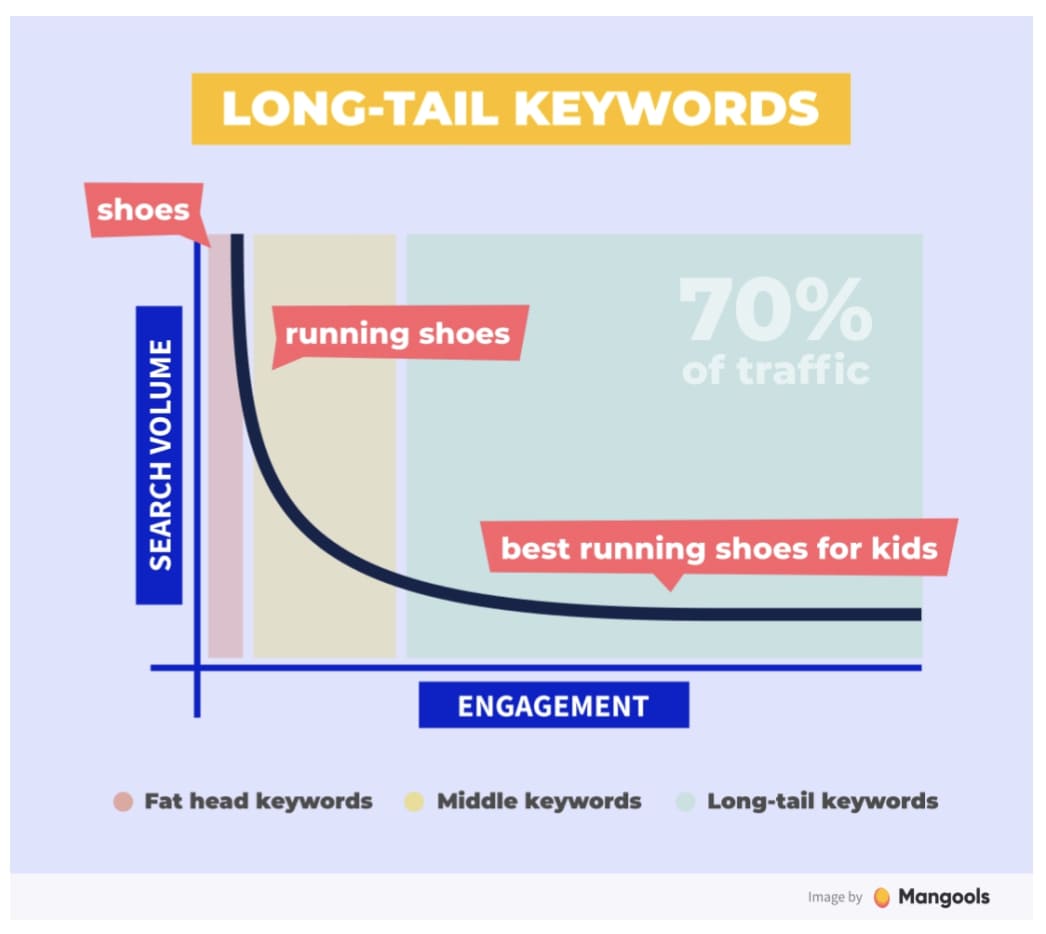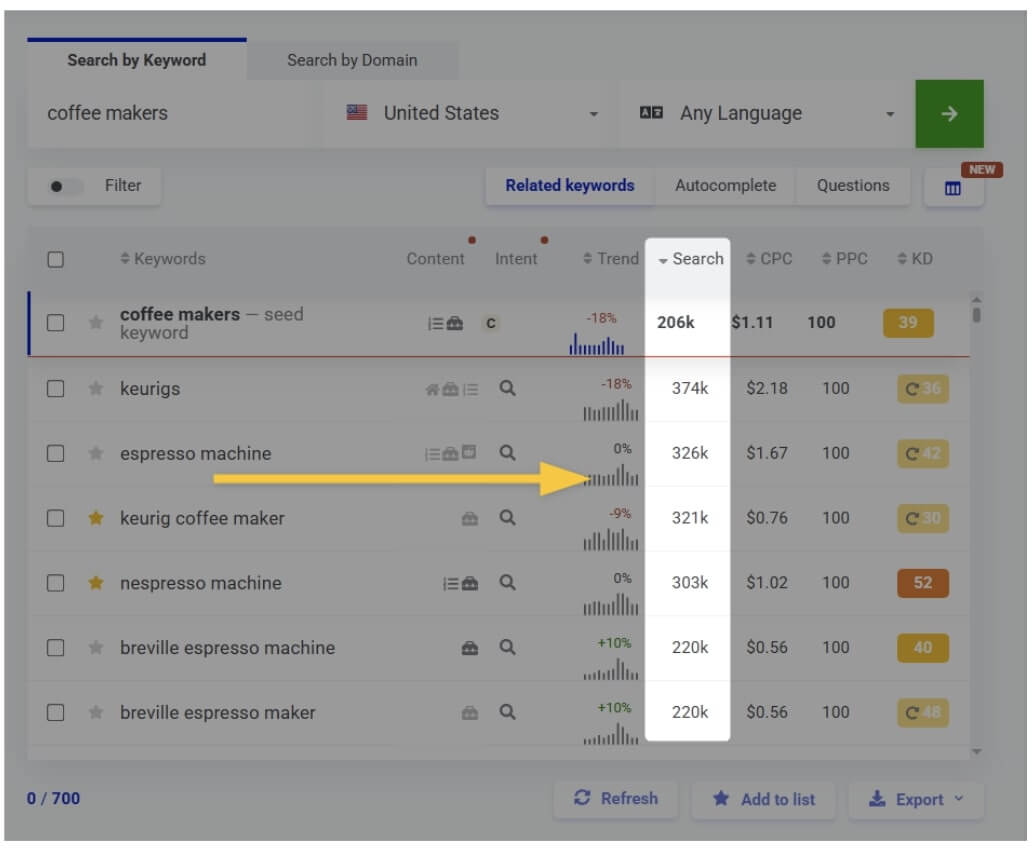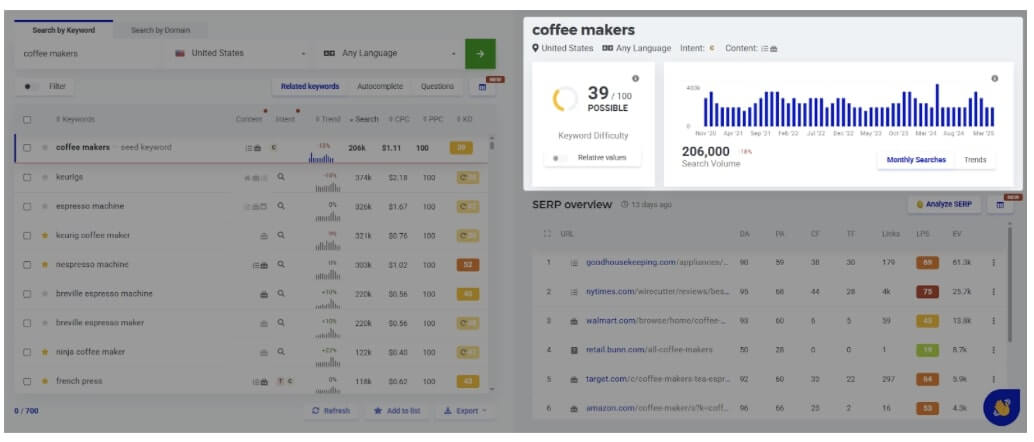Free & Accurate Keyword Volume Checker
Discover high-potential keywords to drive more organic traffic.
What is keyword search volume?
Keyword search volume refers to a number of searches for a given keyword during a selected time frame (usually a month). In most keyword research tools, the number of searches is an average value based on the last 12 months.
Here is an example of the search volume for the keyword 'coffee makers' in Mangools' KWFinder:

Why is search volume important in SEO?
The search volume of a keyword is one of the most important metrics to consider when doing keyword research. Knowing the search volumes of the keywords you want to target can help you:
- prioritize the content topics
- see the search trend of the keyword
- estimate the traffic potential
To put it very simply: You may think you have a perfect keyword, but if nobody really searches for that keyword, you won’t get any visitors to your website even if you rank for it.
How is search volume calculated?
In general, there are two main sources of search volume used in the tools:
- Google data – Google database is still one of the most reliable sources of search volume data, although it may need to be post-processed in order to be precise, as Google tends to cluster similar keywords and show search volume for the whole group instead of single keywords.
- Clickstream data – Clickstream search volume data is collected via browser extensions, plugins and other applications that you install on your computer. The data is aggregated and sold to be used further. Tools like Moz or Ahrefs display search volumes based on the clickstream data.
Both Google data and clickstream data have their pros and cons.
The biggest downside of Google search volumes is that no one really knows how they gather the data. Another important factor is that Google groups topically similar keywords, especially long-tail terms so the data needs to be post-processed to show more precise results for certain keywords.
On the other hand, Google owns amazing data sources, it is by far the biggest database out there.
When it comes to clickstream data downsides, the most significant is that they offer only a small fragment of data when compared to Google.
So the search volume estimates are made from a much smaller sample of keywords and may be less accurate.
While most keyword research tools use Google Keyword Planner as their primary source of keyword search volume data, the search volume values differ.
The reason is that they use various additional sources (like clickstream data) and post-process the keywords to avoid Google’s clustering and show more precise results.
If the same keyword has the search volume 10,000 in one tool and 11,500 in another, it’s perfectly fine.
Factors that affect keyword search volumes
Keyword search volume is not a static metric—it fluctuates due to a wide range of external and internal influences.
Understanding what drives these changes is essential for accurate keyword targeting and more effective SEO strategy.
1. Seasonality
Some keywords follow predictable patterns based on time of year. For example, searches like “Black Friday deals”, “Christmas gifts”, or “summer outfits” surge around specific holidays or seasons.
Planning content ahead of these peaks can help you capture traffic during high-demand periods.
2. Trending topics
Sudden changes in public interest—such as major news, viral content, or social media moments—can trigger sharp spikes in search volume.
A good example is how the keyword “remote work” surged in popularity during the early stages of the pandemic.
While trends can be short-lived, identifying and acting on them quickly gives you a chance to capitalize on topical content before competition grows.
3. Marketing and product launches
Campaigns, ads, influencer promotions, and product announcements can all generate interest—and therefore increase search volume—around brand-related or industry keywords (e.g. “ChatGPT”).
If you're planning a launch, it's worth monitoring how associated keywords perform before and after the campaign goes live.
4. User behavior and lifestyle shifts
Search patterns often reflect evolving lifestyles. For instance, increased interest in “home gym equipment” or “meal delivery services” has mirrored larger social trends like health awareness or remote living.
Adapting to these changes can help you stay aligned with user intent.
5. Market and industry movements
Economic conditions, competitor activities, and product trends can also influence search volume.
If a new smartphone is released, related searches (like “best phone 2025”) may spike. Monitoring your industry’s landscape can uncover emerging opportunities.
What is a good search volume?
The short answer would be – the higher the search volume, the better. A high search volume means the term is popular and if you rank for it, you’ll get more traffic from Google.
But you should also consider other things (like keyword relevance or keyword difficulty) to evaluate whether it is a good idea to target the keyword.
Besides the actual popularity of the keyword, the search volume depends on other things, namely:
- Your niche - If you run a blog about knitting, you’ll hardly find relevant keywords with millions of searches, since your main keyword – knitting – has “only” 62,600 searches per month.
- The selected location - The more you narrow down the location in your search, the fewer monthly searches the keyword has. There may be regional differences too.
- How specific the keyword is - Broader keywords like “weight loss” (213,00) will always have higher search volume than specific phrases like “disadvantages of keto diet” (200).
Types of keywords based on their search volume
Traditionally, we distinguish between 3 categories of keywords based on how many searches per month they have:
- Fat-head keywords – the big, broad keywords with millions of searches like “shoes” or “marketing”
- The “chunky middle” – more detailed keywords like “best running shoes” or “marketing techniques” with (tens of) thousands of searches
- Long-tail keywords – longer keywords with specific search intent having lower search volume but usually higher engagement. Long-tail keywords account for about 70% of all web searches.

However, this categorization is quite vague and the length of the keyword and the search volume do not always correlate.
You can have a long-tail keyword with thousands of searches as well as an unpopular single-word keyword with just a couple of searches per month.
How to find and analyze the search volume of keywords?
If you’re serious about SEO, getting a quality keyword tool with reliable data is a must.
A great advantage of a professional keyword research tool is that besides search volume values, it provides many other useful metrics and data you’ll need when evaluating the keywords. These include:
- keyword difficulty metric
- the search trends
- CPC and PPC values
- SERP results with details about your competitors
Here’s what the search volume column looks like in KWFinder:

All you have to do is simply enter your seed keyword and start analyzing the results in our keyword research tool.
1. Identify seasonal and trending keywords
There are many seasonal keywords with huge search volumes during a specific period of time in a year.
They represent many opportunities to create well-timed content to bring more organic traffic to your website.
Check the search trend in the upper right part of the screen in KWFinder to see the long-term search trend chart

Once you spot keywords that are relevant to your niche, save them to your list so you have them ready for your website when the right time comes.
Tip:
When optimizing for seasonal keywords, it's a good idea to implement them in advance—especially for time-sensitive terms related to events like Black Friday, Christmas, Easter, or Halloween.
This allows Google enough time to crawl and index the updated content.
2. Find hidden keyword opportunities
Seasonal keywords are great for short-term optimization hacks. However, knowing the historical trends and keyword search volumes gives you a lot more value when optimizing for long-term goals.
In KWFinder, there are two tabs in the upper right part of the screen dealing with search trends:
- Monthly Search Volumes: Keyword search volumes with historical data
- Interest Over Time: Google Trends
While long-term keyword search volume lets you see the average search volume in history, Google Trends chart informs you about the overall popularity of the analyzed keyword during the time. Both metrics offer data from up to 2014.

Once you find a trending keyword that is relevant for your niche, go ahead and optimize your content for it.
You may jump on a train of popularity even before one of your competitors finds out. These metrics help you identify keyword ideas that your competitors miss.
3. Get the exact search volume for each keyword
All keywords in KWFinder have exact search volumes—you won’t see any ranges.
Since we post-process the data and attempt to detect close variant keywords to provide more precise search volumes, many of the numbers may not match those in Google Keyword Planner or other tools that rely solely on GKP data.
There are many close variant keywords, and we aim to detect and consolidate them in the following cases:
- American vs. British English (e.g., optimization vs. optimisation, analyze vs. analyse) or other regional language variations
- Abbreviated vs. full-length terms
- Singular vs. plural forms
- Spelling differences (e.g., jobtitle vs. job title)
- Punctuation variations (e.g., children game vs. children’s game)
Check and analyze keyword search volumes
Uncover real search data to power your SEO strategy